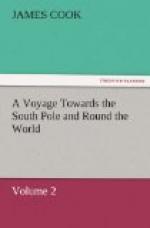The wind now remained invariably fixed at N.E. and E.N.E., and blew fresh with squalls, attended with showers of rain, and the sky for the most part cloudy. On the 25th, in the latitude of 16 deg. 12’ N., longitude 37 deg. 20’ W., seeing a ship to windward steering down upon us, we shortened sail in order to speak with her; but finding she was Dutch by her colours, we made sail again and left her to pursue her course, which we supposed was to some of the Dutch settlements in the West Indies. In the latitude of 20 deg. N., longitude 39 deg. 45’ W., the wind began to veer to E. by N. and E.; but the weather remained the same; that is, we continued to have it clear and cloudy by turns, with light squalls and showers. Our track was between N.W. by N. and N.N.W., till noon on the 28th, after which our course made good was N. by W., being at this time in the latitude of 21 deg. 21’ N., longitude 40 deg. 6’ W. Afterwards, the wind began to blow a little more steady, and was attended with fair and clear weather. At two o’clock in the morning of the 30th, being in the latitude of 24 deg. 20’ N., longitude 40 deg. 47’ W., a ship, steering to the westward, passed us within hail. We judged her to be English, as they answered us in that language; but we could not understand what they said, and they were presently out of sight.
In the latitude of 29 deg. 30’, longitude 41 deg. 30’, the wind slackened and veered more to the S.E. We now began to see some of that sea-plant, which is commonly called gulph-weed, from a supposition that it comes from the Gulph of Florida. Indeed, for aught I know to the contrary, it may be a fact; but it seems not necessary, as it is certainly a plant which vegetates at sea. We continued to see it, but always in small pieces, till we reached the latitude 36 deg., longitude 39 deg. W., beyond which situation no more appeared.
1775 July




